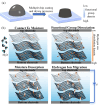Flexible Moisture-Electric Generator Based on Vertically Graded GO-rGO/Ag Films
- PMID: 40572899
- PMCID: PMC12194753
- DOI: 10.3390/ma18122766
Flexible Moisture-Electric Generator Based on Vertically Graded GO-rGO/Ag Films
Abstract
Moisture-electricity generators (MEGs) hold great promise for green energy conversion. However, existing devices focus on the need for complex gradient distribution treatments and the improvement in output voltage, overlooking the important role of the graphene oxide (GO) oxidation degree and the response time and recovery time in practical application. In this work, we develop printed MEGs by synthesizing reduced graphene oxide/silver nanoparticle (rGO/Ag) composites and controlling the GO oxidation degree. The rGO/Ag layer serves as a functional component that enhances cycling stability and shortens the recovery time. Additionally, compared to conventional rigid-structure devices, these flexible MEGs can be produced by inkjet printing and drop-casting techniques. A 1 cm2 MEG can generate a voltage of up to 60 mV within 2.4 s. Notably, higher output voltages can be easily achieved by connecting multiple MEG units in series, with 10 units producing 200 mV even under low relative humidity (RH). This work presents a low-cost, highly flexible, lightweight, and scalable power generator, paving the way for broader applications of GO and further advancement of MEG technology in wearable electronics, respiratory monitoring, and Internet of Things applications.
Keywords: graphene oxide; inkjet printing; moisture–electricity generators; nanogenerators.
Conflict of interest statement
The authors declare no conflict of interest.
Figures







Similar articles
-
Water-based graphene oxide inks for inkjet-printed flexible moisture energy generators.Sci Rep. 2025 Jul 9;15(1):24685. doi: 10.1038/s41598-025-09628-1. Sci Rep. 2025. PMID: 40634496 Free PMC article.
-
Low-Humidity-Dependent and Stretchable Moisture-Electricity Generator Based on Ti3C2Tx MXene-Loaded Cotton and Hydrogel Bilayer for Green Power Harvesting and Wearable Electronics.ACS Appl Mater Interfaces. 2025 Aug 27;17(34):48375-48386. doi: 10.1021/acsami.5c11850. Epub 2025 Aug 18. ACS Appl Mater Interfaces. 2025. PMID: 40824235
-
Constructing Water-Retaining/Ion-Regulating Bi-Layers for Highly Durable, All-Climate, Efficient Moisture Electric Generators.Adv Mater. 2025 Jul;37(27):e2416008. doi: 10.1002/adma.202416008. Epub 2025 May 2. Adv Mater. 2025. PMID: 40317535
-
The clinical effectiveness and cost-effectiveness of enzyme replacement therapy for Gaucher's disease: a systematic review.Health Technol Assess. 2006 Jul;10(24):iii-iv, ix-136. doi: 10.3310/hta10240. Health Technol Assess. 2006. PMID: 16796930
-
Technological aids for the rehabilitation of memory and executive functioning in children and adolescents with acquired brain injury.Cochrane Database Syst Rev. 2016 Jul 1;7(7):CD011020. doi: 10.1002/14651858.CD011020.pub2. Cochrane Database Syst Rev. 2016. PMID: 27364851 Free PMC article.
References
-
- Bao X., Hou S.H., Wu Z.X., Wang X.D., Yin L., Liu Y.J., He H.L., Duan S.C., Wang B.L., Mao J., et al. Mechanical properties of thermoelectric generators. J. Mater. Sci. Technol. 2023;148:64–74. doi: 10.1016/j.jmst.2022.10.081. - DOI
-
- Lei H., Chen Y.F., Gao Z.Q., Wen Z., Sun X.H. Advances in self-powered triboelectric pressure sensors. J. Mater. Chem. A. 2021;9:20100–20130. doi: 10.1039/D1TA03505C. - DOI
-
- Mustakim N.S.M., Kamaruzaman D., Abdullah M.H., Malek M.F., Parimon N., Ahmad M.K., Abu Bakar S., Vasimalai N., Ramakrishna S., Mamat M.H. Review of recent advances in piezoelectric material for nanogenerator application: Preparation methods, material selection, performance, applications, and future outlook. J. Mater. Sci. 2024;59:19003–19022. doi: 10.1007/s10853-024-10293-4. - DOI
-
- Zhang H., Sum M.Z., Meng Q., Li H., Tian Y.H. Polymer engineering in hydrogel-based moisture-electric generators for green energy harvesting. Soft Sci. 2025;5:23. doi: 10.20517/ss.2025.05. - DOI
Grants and funding
LinkOut - more resources
Full Text Sources

